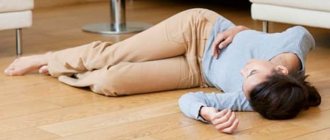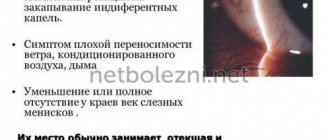Publication date: August 21, 2020
Sometimes, when you have to change your body position, darkening occurs in your eyes. And this is usually associated with various pathologies. Although this phenomenon is not always a danger signal. The eyes also become dark in a healthy person when there is overwork caused by heavy physical exertion or a stressful condition. Often the symptom of darkening in the eyes occurs when standing up. It may recur regularly or may be a one-time occurrence. Darkening in the eyes that appears sporadically does not indicate visual impairment. This is only a short-term deterioration in the perception of the environment. And the exact cause of darkening in the eyes can be determined by a doctor at a medical center by conducting diagnostic examinations.
Blood pressure problems
Dizziness, quite severe, often occurs in people with low blood pressure. Their blood pressure sometimes drops below 100/60 mmHg. And it leads to severe discomfort in the body: tinnitus, dark spots in the eyes and severe headaches. This condition often leads to fainting. Low blood pressure is often observed in pregnant women and teenage children. Therefore, if a person is aware of his low blood pressure, then he does not need to make sudden movements.
What should you do if your vision gets dark after you get up?
Often, as already mentioned, this condition does not last long. To get rid of it faster, you can resort to some remedies. For example, drink strong black sweet tea. It should normalize blood pressure and bring you back to normal. Also, if possible, lie down and raise your legs up. This will allow the blood to distribute evenly throughout the body. If lying down is not possible, then sit down and rest your head on your knees. You can also get rid of darkening when standing up with the help of medications, but before using them you should consult a doctor and find out the cause of this condition. If you are often subject to darkening of your vision, try not to drive at such times, or work with traumatic objects. As a preventive measure, engage in physical exercise, watch your diet and take vitamins.
Vegetative-vascular dystonia
This disease often occurs in adolescents. It is associated with insufficient maturity of the endocrine and nervous systems. Manifest in one-time attacks or have a chronic course.
The resulting darkness in the eyes is characteristic of hypotensive dystonia. During the next attack, a person’s pulse quickens and his vision darkens. Such patients complain that the chest is heavy, there is not enough air, and there is weakness with headache. Symptoms of vegetative-vascular dystonia include cold extremities and frequent fainting.
Dystonia is caused by exhausting physical activity, vitamin deficiencies, and poor nutrition among middle-aged people.
Acute hypotension
The most common causes of a sharp deterioration in vision, complicated by weakness throughout the body and loss of consciousness, include acute or chronic hypotension - low blood pressure. An attack can be triggered by exposure to heat, heavy physical work, and even a sudden change in body position.
Low blood pressure causes an uneven supply of blood to the brain, which causes oxygen starvation. Due to the fact that the optic nerves connect directly to the main organ of the nervous system, the problems that arise primarily affect the eyes.
What not to do?
If a person does not know the cause of the attack, it is prohibited to take any medications. Otherwise, you may harm your health. You should not make sudden movements, you should not quickly turn your head or tilt it down, as this can lead to a fall. You definitely need to visit a doctor or call a medical team to your home.
Squatting and bending are prohibited. You need to take the most comfortable position possible. You should not start smoking or drinking alcohol after the attack is over.
Where to sign up for testing
The easiest way to choose a diagnostic center in St. Petersburg is through our service. There is comprehensive information about addresses, telephone numbers, and opening hours of clinics. You can find out what protocols are used for the examination. Clarify the qualifications of doctors and equipment models. Using the website, it is easy to find out which medical centers are ready to accept patients with limited mobility, and where parking is provided on the territory of the institution. It is convenient to reserve a coupon and receive up to 1000 rubles discount on diagnostics by phone. Our specialists will answer all questions daily from 8:00 to 24:00. The service is free.
Fainting in a child
Fainting in a child is a short-term loss of consciousness. Initially, the child complains of severe weakness, he is bothered by tinnitus, headache, and darkening of the eyes. His skin turns pale, his eyes roll back and he falls. If a child falls, he or she may be injured or hit hard. The child may be unconscious for several seconds to minutes. Afterwards he begins to come to his senses, but he still feels weak and has pain in his head. Young children may fall asleep immediately after fainting. What reasons contribute to this situation?
If a child suddenly faints, the reason is a disruption in the functioning of the brain due to a sharp outflow of blood. For some time, the little patient loses sensitivity and cannot control his movements.
Symptoms:
- a sudden surge of weakness - the child sag, the skin turns pale;
- mild attack of vertigo, darkening of the eyes;
- nausea, severe tinnitus;
- unstable pulse;
- increased sweating.
The baby suddenly sinks to the ground and does not react to what is happening around him for half a minute. After the fallen person has regained consciousness, he does not realize for some time what happened to him, being in prostration.
At the rehabilitation stage, the victim begins to have a headache, nausea, and unpleasant discomfort in the chest or heart. This condition can last for some time, and depends on the cause of sudden fainting and weakness in the teenager, and first aid.
Causes:
- lack of vitamins. Low hemoglobin;
- lack of nutrition. Low blood sugar;
- strong cry, fright, stress, fear;
- pathologies of blood vessels, heart;
- overwork.
External factors
- A sharp increase in temperature outside.
- Lack of oxygen.
- Increased levels of carbon oxides in the air.
The causes of fainting in children may be different, but they do not go away without leaving a trace. If treatment for the pathological condition is not started in a timely manner, the syndrome will subsequently be accompanied by constant dizziness, nausea, headaches, and memory problems.
Internal factors
If a child’s fainting and nausea are short-term, this is a reason to think about changing the daily routine. Systematic loss of consciousness is a pathological condition that cannot be ignored.
Fainting, ailments in adolescents and their causes may be associated with the following diseases:
- Brain diseases. Cystic formations, tumors, and injuries to the vascular network reduce the efficiency of the “gray matter” functioning, causing fainting. If a child complains of darkening of the eyes, headaches, or hallucinations, it is necessary to urgently consult a doctor and undergo a CT and MRI.
- Anemia. Pathology of the circulatory system associated with the functioning of the organ: low levels of red blood cells - oxygen carriers, cause starvation, which leads to constant fainting. Low hemoglobin is the first sign of the onset of the disease. It is necessary to review the child’s diet, supplement it with fruits, vegetables, and nutrients.
- Impaired performance of the heart muscle, arrhythmia. According to statistics, 30% of crises are associated with heart pathologies; in addition, the “quick death” syndrome is preceded by constant fainting. If the baby’s parents suffer from similar diseases, this is the first warning call - the child needs to be shown to the doctor urgently.
- High pressure. Hypertension can overtake a patient, even at a young age. A sudden drop in blood pressure can also cause syncope.
- Diabetes. This disease is quite insidious: it can occur in a latent form for a long time. The pathology itself does not cause fainting, but it can be triggered by low glucose levels. Due to starvation of the “gray matter” cells, the baby loses consciousness.
- Concussions, TBI. Children are hyperactive; they lose their balance and fall, which is normal for them. After a short cry, they can continue to go about their business, but sometimes the consequences of a fall can remind themselves for a long time.
- Osteochondrosis. Ideal posture is the key to a healthy back and proper functioning of internal systems, but this is difficult to prove to children. A crooked posture at the table and excess body weight lead to changes in the spinal column. Blood flow is disrupted, starvation occurs, and painful discomfort appears. All these factors are the main causes of syncope.
Diagnostics
The following specialists can diagnose the cause of fainting:
- pediatrician;
- cardiologist;
- neurologist.
To clarify the diagnosis, you will be referred for tests and studies:
- Clinical analysis of urine and blood;
- biochemical blood test;
- EEG;
- MRI;
- CT;
- Ultrasound.
First aid for fainting
- Place the victim on a horizontal surface. Raise your legs slightly to ensure adequate blood flow to the “gray matter.”
- If you faint, you should let your child smell ammonia or pat him on the cheeks. This will allow the baby to regain consciousness.
- After the condition has normalized, the victim should be given sweets - chocolate, candy, tea with sugar. The baby should lie down until he comes to his senses.
- Ensure proper oxygen circulation. If the attack occurs indoors, you should open the doors and windows, allowing air to flow into the room. In case of a large crowd of people, you must ask them to move away from the baby.
The Epihelp clinic offers diagnostics and treatment. Qualified doctors will draw up a treatment plan. With our clinic, your child will recover much faster!
Etiology
This symptom can be caused by benign reasons, such as improper selection of glasses and lenses, alcohol abuse, and an unbalanced diet. This effect is sometimes provoked by taking certain medications, heat or sunstroke, and presyncope.
Pathological etiofactors are:
- Migraine;
- Tension headaches;
- Injuries;
- Stenosis of blood vessels in the neck and head;
- Damage to vascular walls;
- Arterial hypertension;
- Hypotension;
- Systemic diseases, for example, diabetes, multiple sclerosis, and so on;
- Hypochromic anemia;
- Tumors of various origins;
- Osteochondrosis of the cervical spine;
- Spinal cord compression;
- Hormonal imbalance;
- Inflammatory processes in the eyeball;
- Eclampsia;
- Oscillopsia;
- Drug ototoxicity;
- Retinal detachment or tear;
- Vitreous detachment.
Treatment of dizziness and noise in the head
The main principle of treatment for dizziness and noise in the head is its cause and mechanism of development. Therapy should be aimed at relieving the patient of the symptoms of the disease.
Drug therapy
If the patient has dyscirculatory encephalopathy, drugs are prescribed that normalize cerebral perfusion through an effect on the cardiovascular system. These are diuretics, beta blockers and vascular agents, as well as neurometabolites.
If symptoms occur due to high blood pressure, the doctor will prescribe antihypertensive drugs that control blood pressure levels and keep them within normal ranges. In this case, beta blockers, ACE inhibitors, calcium channel antagonists and diuretics help well.
For cerebrovascular disorders, nootropics, vasodilators, antiplatelet agents and anticoagulants are prescribed.
Kazieva Aminat Ziyavovna
Neurologist
Rostov State Medical University
Experience since 2012
After suffering injuries, to alleviate the condition, patients are recommended to limit physical activity and emotional stress, as well as symptomatic therapy to alleviate the patient’s condition. For this purpose, painkillers and anti-inflammatory drugs from the group of non-steroidal anti-inflammatory drugs are prescribed during periods of deterioration in health.
If the disorder occurs due to a functional cause, such as a tumor, then prompt surgical intervention is necessary.
If a patient has a migraine, the doctor should prescribe preventative treatment to prevent relapses of attacks, as well as medications to stop new episodes of migraine.
To correct anemia and its consequences, a specialist prescribes iron-based antianemic drugs, which can quickly increase the level of hemoglobin in the blood and relieve the symptoms that arise.
During menopause in women, the symptoms of menopause are corrected by menopausal hormone therapy.
Before a long trip in transport, you need to take special anti-motion sickness medications.
Physiotherapy
Physiotherapeutic procedures help, in addition to drug treatment, to get rid of the disease. The most common in treatment:
- Magnetotherapy.
- Laser therapy.
- Massage and physical therapy.
- Healthy swimming.
- Acupuncture.
With systematic, course use of these therapeutic methods, there is a decrease in the symptoms of the disease and their complete disappearance.
Nutrition
An important aspect in monitoring your health and well-being is your diet. A balanced diet rich in vitamins, micro and macroelements allows you to maintain normal blood counts, weight and nutrient levels in the body. Excluding easily digestible carbohydrates, sugar, fatty and fried foods from your daily diet will help avoid cardiovascular diseases, which lead to a systematic increase in blood pressure, as well as type II diabetes and surges in sugar levels.
Kazieva Aminat Ziyavovna
Neurologist
Rostov State Medical University
Experience since 2012
It is equally important to comply with the daily calorie intake, as well as proteins, fats and carbohydrates in the diet. Daily caloric intake is calculated based on a person’s weight and energy expenditure. With a calorie deficit and abuse of fasting and diets, the body experiences stress, which is accompanied by poor health.
Causes
Symptoms such as dizziness and darkening of the eyes may indicate problems in the body or the presence of somatic or neurological diseases.
The reasons for this condition may be:
- when standing up suddenly, blood pressure decreases, blood is improperly distributed among the vessels and flows away from the brain;
- in adolescents, pregnant women, people with an asthenic (thin) physique due to dystonia, low blood pressure;
- low hemoglobin level;
- neurological conditions (stress, emotional fatigue, being in a state of uncertainty for a long time);
- pathologies of the heart and blood vessels, malfunctions in their work (atherosclerosis, coronary artery disease, varicose veins);
- consequences of weather changes for weather-sensitive people;
- during physical activity;
- diabetes mellitus and retinopathy;
- diseases of the organ of vision (cataracts, glaucoma, increased intraocular pressure);
- diseases of the musculoskeletal system (arthritis, osteoporosis, osteochondrosis);
- taking certain medications that sharply lower blood pressure (Nifedipine, Capoten, Nitroglycerin);
- diet, hunger, dehydration.
Folk remedies
Traditional methods will help reduce swelling and inflammation of the eye mucosa. These include cool compresses on the eyelids. And:
- Chamomile decoction;
- Cucumber juice mixed one to one with water.
We must remember that these methods also have contraindications. Therefore, it is better to first consult with a specialist. If attacks recur, it is necessary to undergo examination.
Diagnostics
To diagnose the primary disease that has led to the appearance of fog before the eyes, you need to perform, at a minimum, biomicroscopy using a slit lamp and examine the fundus with a wide pupil. In this case, it is often possible to identify signs of damage to the cornea, lens, vitreous body or retina [7].
Testing vision with and without correction, as well as determining refraction in conditions of a dilated pupil (cycloplegia) will help identify disorders such as spasm of accommodation, myopia, farsightedness and astigmatism.
Determination of intraocular pressure (IOP) excludes or confirms glaucoma.
Fig. 6 Basic examination (biomicroscopy and ophthalmoscopy) allows in most cases to identify the cause of the appearance of fog
In some cases, additional examinations are necessary to clarify the diagnosis—primarily optical coherence tomography of the retina (including with angiography function) [8]. This method allows you to see minimal changes in the central zone of the retina and the optic nerve head (ONH), accurately and quickly make a diagnosis and prescribe treatment. This test is available in our clinic on the same day of your visit.
| Study | Signs | Disease |
| Vision testing with and without correction | Descending into the distance | Myopia, farsightedness, astigmatism, accommodation spasm |
| Measuring intraocular pressure | Promotion | Acute attack of glaucoma |
| Biomicroscopy of the cornea | Swelling, cloudiness | Keratitis |
| Biomicroscopy of the lens | Cloudiness | Cataract |
| Vitreous ophthalmoscopy | Cloudiness, peeling | DST, ZOST |
| Retinal ophthalmoscopy | Swelling, ruptures, detachment | Macular degeneration, retinal detachment and tears |
| Ophthalmoscopy of the optic disc | Swelling, pallor | Optic neuritis, glaucoma, atrophy |
Table 1. Research method, signs and final diagnosis









